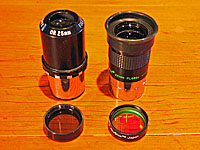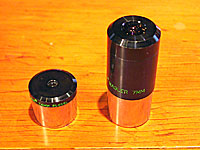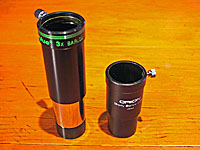

Eyepieces

Maybe eyepieces are not accessories - you can't very well use a telescope without an eyepiece, but they are always treated separately, and so will we. An eyepiece takes the image formed by the primary mirror near the top of the focuser and magnifies it for presentation to the observer. By using eyepieces of different focal lengths and lens configurations, you can change the magnification of the telescope and to some extent the field of view.
You already know from the design and focuser sections that eyepieces come in two standard sizes: 1¼ and 2 inch diameters. There are many other characteristics we will describe below.
Eyepiece Characteristics
Focal Length and Magnification: A shorter focal length eyepiece provides higher overall magnification and (within the same type) a smaller field of view. Eyepiece focal lengths are measured in millimeters, and are typically in the range of 5mm to 50mm (note that 1¼ inch eyepiece are limited by barrel diameter to a maximum of 32mm). Using the same units of length for your telescope (primary mirror) focal length and the eyepiece, the magnification of the system can be calculated as:
Magnification = Telescope Focal Length / Eyepiece Focal Length
Longer focal length eyepieces cost more because the are physically larger and use larger lenses.
Apparent and Actual Field of View: Eyepieces have an apparent field of view (typically between 35° to 100°) which when divided by the magnification (as calculated above) gives you the actual field of view (the result is in angular units, i.e. the angle on the sky that your view will include). The apparent field of an eyepiece is closely tied to it's type, or lens configuration, and you will find apparent fields are available in only certain ranges, typically 52°-55°, 68°, 82° and just recently (2009) 100°. You will pay more for wider fields of view, because they require more lenses and more expensive types of glass.
Eye Relief: An eyepiece forms a focused image a certain distance behind the lens closest to the eye - this is referred to as eye relief, and is the distance you eye needs to be behind the eyepiece. Many eyepieces incorporated a rubber eye cup on the barrel to naturally space your eye back the required distance. Short focal length eyepieces often have (uncomfortably) short eye relief, whereas most long focal length eyepieces usually have correspondingly long eye relief. Typical eye reliefs are in the 2mm to 20mm range. People who wear eyeglasses at the telescope can have difficulty using short eye relief eyepieces. If you want long eye relief even in short focal length eyepieces, they are available, but again at added expense due to requiring added lenses and/or more expensive glass.

Type, or Lens Configuration: There are more eyepiece types we can possible list here, so what follows is a list of the currently most popular and available eyepiece types. We will us generic names first, and then if a particular brand name defined the type or dominates the field, that will be in italics in parenthesis:
- Orthoscopic or "Abbe": 4 elements, 40°-45° apparent field.
- Plössl: 4 or 5 elements, 50°-55° apparent field.
- Wide Angle/Field (Panoptic): 6 elements, 67°-68° apparent field.
- Super/Ultra Wide Field/Angle (Nagler): Up to 8 elements, 82°-84° apparent field.
- 100° (Ethos): 'lots of' elements, 100° apparent field.
While more elements are used to get better fields of view and/or eye relief, every element used contributes to a small loss of light and possible additional distortions if not very well made. The list is ordered in terms of increasing cost.
Coatings: Better quality eyepieces have anti-reflection coatings to reduce or eliminate 'ghost images' caused by reflections from internal lens surfaces and to reduce light loss due to reflections.
Filter Threads: Most eyepieces have threaded lower barrels to accept 30mm (1¼ inch eyepieces) or 48mm (2 inch eyepieces) filters, which are used in some situations to improve the view.
Zoom Eyepieces
Zoom eyepieces are available, but have not gained much market share. The added complexity and lenses required to do zooming can produce dimmer and/or less sharp images. While newer model are getting better and better, very few amateurs use them, and we would not recommend them.
Barlow Lenses

A Barlow Lens is inserted between the focuser and the eyepiece, and it effectively shortens the focal length of the eyepiece to increase magnification. Typical Barlow Lenses increase magnification by 2x to 5x, depending on the model you purchase. Of course, you are adding additional lenses to your system, so there is some light loss and any errors in the Barlow Lens will accumulate in your final image, so avoid the real low end units. Barlows have been popular for a long time, and many good ones are available today. If you had a 25mm, 20mm and 15mm eyepiece set, a 2x Barlow Lens would also give you the option of viewing at 12.5mm, 10mm, and 7.5mm.
What Should I Buy?
There are so many variables, and so many personal preferences, that we are not going to provide a comprehensive answer. Our advice would be to purchase a 25mm or 20mm Plössl, which is a good general purpose eyepiece for almost any scope, and it will get you started. Many, many manufacturers make them, and most commercial Dobsonian telescopes are shipped with one; Plössls have become the standard eyepiece of the industry because they offer the widest field of view and excellent images of all the simple eyepiece designs.
What should your next eyepiece be? If you can go to a star party (check you local astronomy) club, you can probably look through a variety of telescopes with various types and sizes of eyepieces. Some amateurs might even let you borrow an eyepiece to try in your own telescope for a few minutes. It is much better to try out in actual use various eyepieces, rather than try to figure out what you might be happy with by looking at characteristics. And of course, most of us have some sort of budget, so a complete set of the latest super-duper wide field eyepieces is probably not in the short term plan.
It is, however, instructive to work with some numbers, to get an idea about what focal lengths and apparent fields might give you a set of 3 or 4 eyepieces to observe a variety of different objects. Planets, planetary nebula and splitting double stars call for high magnifications, while many deep sky objects such are nebulas, star fields and star clusters call for wide fields (and therefore usually low magnification). Use the Eyepiece Tab in Newt-Web which will take loaded telescope design and compute key eyepiece characteristics when used in that scope.
Previous: Collimation Next: Dust
Covers & Dust Caps
Back to the Build a Dobsonian Master
Index